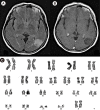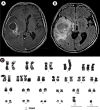Relationship Between Cytogenetic Complexity and Peritumoral Edema in High-Grade Astrocytoma
- PMID: 27578512
- PMCID: PMC5011112
- DOI: 10.3343/alm.2016.36.6.583
Relationship Between Cytogenetic Complexity and Peritumoral Edema in High-Grade Astrocytoma
Abstract
Background: The purpose of the study is to reveal the association of cytogenetic compltyexi and peritumoral edema volume (PTEV) and its prognostic significance in high-grade astrocytoma patients by culturing patient tumor cells.
Methods: Twenty-seven high-grade astrocytoma patients were divided into three groups according to karyotype complexity: normal, non-complex karyotype (NCK), and complex karyotype (CK). Endothelial growth factor receptor (EGFR) amplification was detected by FISH, and its association with chromosome 7 abnormalities was analyzed. Mean PTEV of each group was compared by ANOVA to evaluate the relationship between PTEV and cytogenetic complexity.
Results: The PTEV of patients in normal (n=6), NCK (n=8), and CK (n=13) groups were 24.52±17.73, 34.26±35.04, and 86.31±48.7 cm³, respectively (P=0.005). Ten out of 11 patients with EGFR amplification showed abnormalities in chromosome 7. The mean PTEV of EGFR-amplified and non-amplified groups were 80.4±53.7 and 41.3±37.9 cm³, respectively (P=0.035). The average survival of patients with PTEV less than 90 cm³ was 30.52±26.11 months, while in patients with PTEVs over or equal to 90 cm³, it was 10.83±5.53 months (P=0.007).
Conclusions: The results show an association of complex karyotype with the PTEV of high-grade astrocytoma. EGFR amplification plays a significant role in the formation of peritumoral edema, causing PTEV to increase, which is related with survival. This implies that cytogenetic karyotype can be applied as a prognostic factor.
Keywords: Chromosome; EGFR amplification; High-grade astrocytoma; Peritumoral edema.
Conflict of interest statement
Authors' Disclosures of Potential Conflicts of Interest: No potential conflicts of interest relevant to this article were reported.
Figures



Similar articles
-
Post-treatment changes of tumour perfusion parameters can help to predict survival in patients with high-grade astrocytoma.Eur Radiol. 2017 Aug;27(8):3392-3400. doi: 10.1007/s00330-016-4699-2. Epub 2016 Dec 20. Eur Radiol. 2017. PMID: 27999986
-
Peritumoral Edema Affects the Prognosis in Adult Pleomorphic Xanthoastrocytoma: Retrospective Analysis of 25 Patients.World Neurosurg. 2018 Jun;114:e457-e467. doi: 10.1016/j.wneu.2018.03.007. Epub 2018 Mar 12. World Neurosurg. 2018. PMID: 29545226
-
[Application of apparent diffusion coefficient and fractional anisotropy in identification of tumor component and grading of brain astrocytoma].Zhonghua Yi Xue Za Zhi. 2008 Dec 23;88(47):3352-5. Zhonghua Yi Xue Za Zhi. 2008. PMID: 19257968 Chinese.
-
Gain of chromosome 7, as detected by in situ hybridization, strongly correlates with shorter survival in astrocytoma grade 2.Genes Chromosomes Cancer. 2002 Mar;33(3):279-84. doi: 10.1002/gcc.10029. Genes Chromosomes Cancer. 2002. PMID: 11807985
-
Potential Utility of Visually AcceSAble Rembrandt Images Assessment in Brain Astrocytoma Grading.J Comput Assist Tomogr. 2016 Mar-Apr;40(2):301-6. doi: 10.1097/RCT.0000000000000352. J Comput Assist Tomogr. 2016. PMID: 26978002
Cited by
-
The combination of radiomics features and VASARI standard to predict glioma grade.Front Oncol. 2023 Mar 22;13:1083216. doi: 10.3389/fonc.2023.1083216. eCollection 2023. Front Oncol. 2023. PMID: 37035137 Free PMC article.
-
Up-regulation of LINC00665 contributes to the progression of glioma and correlates with its MRI characteristics.Am J Transl Res. 2022 May 15;14(5):2988-3002. eCollection 2022. Am J Transl Res. 2022. PMID: 35702084 Free PMC article.
References
-
- Ohgaki H, Kleihues P. Population-based studies on incidence, survival rates, and genetic alterations in astrocytic and oligodendroglial gliomas. J Neuropathol Exp Neurol. 2005;64:479–489. - PubMed
-
- Heimberger AB, Hlatky R, Suki D, Yang D, Weinberg J, Gilbert M, et al. Prognostic effect of epidermal growth factor receptor and EGFRvIII in glioblastoma multiforme patients. Clin Cancer Res. 2005;11:1462–1466. - PubMed
-
- Stupp R, Mason WP, van den Bent MJ, Weller M, Fisher B, Taphoorn MJ, et al. Radiotherapy plus concomitant and adjuvant temozolomide for glioblastoma. N Engl J Med. 2005;352:987–996. - PubMed
-
- Barker FG, 2nd, Simmons ML, Chang SM, Prados MD, Larson DA, Sneed PK, et al. EGFR overexpression and radiation response in glioblastoma multiforme. Int J Radiat Oncol Biol Phys. 2001;51:410–418. - PubMed
MeSH terms
Substances
LinkOut - more resources
Full Text Sources
Other Literature Sources
Medical
Research Materials
Miscellaneous

